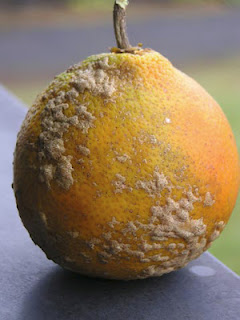What causes the scabby bumps on citrus fruit? This disorder, common in high rainfall areas, is called citrus scab. The disease occurs in Hawaii, as well as in Florida, but not in California due to the dry climate. It is caused by a fungus, Elsinoe fawcetti, and affects a wide range of citrus.
The light brown, raised, warty scabs appear on young stems, leaves and fruit. Leaves develop some resistance to citrus scab with age. The scabs consist of the body of the fungus plus the swollen tissue of the host plant.
Spores are produced within these scabs and will spread to other tissues by the splashing rain or irrigation water. Infection occurs when the spores germinate on a susceptible plant surface that remains wet for approximately 3 to 4 hours.
Control
· Select a resistant species or variety.
· Plant in a sunny and dry location as is available.
· Intercrop citrus with non-citrus plants or resistant citrus trees.
Citrus scab can reduce yield and will certainly reduce the quality of the fruit. For home production, as bad as it looks, the fruit can still be sweet and juicy. For those caring about the external appearance of the fruit, trees can be sprayed with a copper fungicide. Yet even numerous applications may not be effective in high rainfall areas.
Highly susceptible citrus types: Fremont, Clementine, Murcott and Frost Satsuma mandarins; Orland Tangelo; Tahitian lime and Rangpur lime, often referred to as the common lemon in Hawaii.
Not susceptible or immune citrus types: Sweet orange, navel orange, pummelo and grapefruit.


